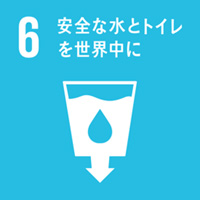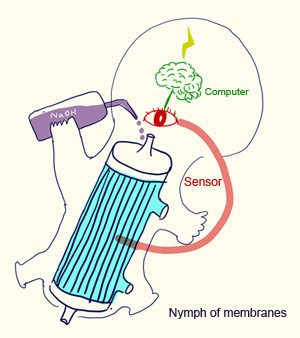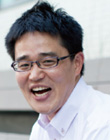The Nymph of Membranes Will Save Water Infrastructure in the Future!?
Hiroshi Yamamura
Associate Professor, Department of Integrated Science and Engineering for Sustainable Society, Faculty of Science and Engineering, Chuo University
Areas of Specialization: Environmental Technologies and Materials, Civil Engineering and Environmental Systems
Future of the polarized water infrastructure
We use water supply and sewerage systems everyday without thinking. These are the water infrastructure developed quickly during the rapid economic growth period in the 1960s, and it is said that water is supplied to 99% of citizens and drainage treatment facilities will be completed in 10 years. However, outside Japan, there still exist those who carry a heavy tank for over 2 hours to get water and come back home and those who do not know toilets. The current situation of water infrastructure clearly represents the polarized world.

Clean Water and Sanitation
In developing countries, the swift distribution of water infrastructure is strongly demanded, because average life expectancy depends on the penetration rate of water supply systems. For the UN Millennium Development Goals (MDGs), the United Nations took the initiative and many countries joined hands to dig wells and develop water supply systems with the goal of halving the population who cannot access safe water by 2010, and attained that goal earlier than expected. On the other hand, the development of water supply systems augmented the volume of sewage water, and the water environment has been worsening considerably in recent years. In Phnom Penh, the capital of Cambodia, there is only one effluent treatment facility in the urban center, and other sewer water is discharged to lakes and rivers as it is, and what is worse, the urban areas of developing countries are expanding disorderly to the suburbs, and the development of infrastructure does not keep up with it. Out of 17 Sustainable Development Goals (SDGs) of the United Nations, Goal 6 is to improve sanitary equipment, and distribution of toilets, and increase of the rate of installation of drainage treatment facilities are to be achieved by 2030.
Meanwhile, developed countries, including Japan, are faced with emerging issues regarding water infrastructure. In Flint, a major city in the vicinity of Detroit, the U.S., the lead included in water pipes dissolved into tap water due to a budget shortfall and simple technical mistakes, and the then President proclaimed a state of emergency and the use of tap water was restricted. In Japan, too, debates about the deterioration and sustainability of water infrastructure are becoming active. As mentioned above, the water infrastructure in Japan was rapidly constructed in 1960. Since its lifespan is 50 years, we are about to enter the renewal period in 2020. Considering the decrease in the population, the declining birthrate, the aging society, the drop in the number of engineering staff members, etc., we cannot say that the outlook for Japanese water infrastructure is bright. It is forecasted that it will be more difficult to secure funds and manpower to construct, maintain, and manage the infrastructure, and we need to prepare for surviving in a mountain in the winter.
Video of news about the lead pollution in Flint
https://www.youtube.com/watch?v=PNY7gSqRgnE
Expectations toward membrane filtration, and disappointing results
Filtration and disinfection are essential technologies for securing safe water, as it can be said that water treatment begins with filtration and ends with disinfection. If filtration is effective, it is possible to reduce the burden of disinfection. Accordingly, it is no exaggeration to say that the efficiency of water supply systems depends on filtration. Up until now, the primary method has been the sand filtration method, in which tiny dirt adheres to the sand surface and is removed. Since very advanced skills for determining the amounts of chemicals to be added, the timing of cleansing, etc. are required for producing safe water with sand filtration, it is indispensable to employ personnel who possess such skills. Since sand filtration cannot remove all dirt, the sterilization by chlorination plays an important role in public health, but there exist pathogenic organisms resistant to chlorination in water, so it is technically difficult to achieve flawlessness.

Differences between membrane filtration and sand filtration
In these circumstances, the membrane filtration technology was invented. A membrane has a porous structure for blocking pathogenic organisms larger than the pores when water permeates the membrane. This technology started attracting attention in the 1990s, and Japan’s largest membrane treatment plant was constructed in Kawai Purification Plant in Yokohama City. In membrane filtration, particles are sieved and separated, so it is possible to produce much safer water than sand filtration. Since it is possible to produce safe water just by making water flow through a membrane, sophisticated technologies are not required, which is a merit. On the other hand, when filtration is continued, pores are clogged, preventing water from permeating them. The pores of a membrane are clogged with impurities, just like a rice strainer is clogged with rice. To solve this clogging problem, the surface of the membrane is washed with air or water, and clogging materials are decomposed and cleansed away with chemicals, but in order to do efficient operation, it is indispensable to optimize filtration and cleansing methods according to the water quality of the river or lake as a water source. The quality of water of the river or lake as a water source varies broadly from place to place and throughout the year, so this optimization usually takes a minimum of 1 year and a maximum of 5 years. Therefore, when a membrane is actually installed in a water purification plant, it is necessary to conduct tests for optimization using funds and manpower for a long period of time. The tag line: “With a membrane, everyone can purify water easily and surely” is turning out to be false, and as it is being revealed that “a membrane can be used stably and continuously only by experts after one or more years of on-site tests,” people’s expectations toward membranes are changing to disappointment and give-up. I think that now is the time to reestablish the technology as a membrane technology that can be used by anyone, in order to bring out the intrinsic merits of membrane filtration.
To infuse membranes with life
If a membrane detects its own stains and performs with optimal filtration conditions and detergents, anyone will be able to obtain safe water anytime without advanced engineers. Our laboratory is developing a device for detecting the clogging of a membrane, to embody an autonomic membrane filtration, in which each membrane will detect its own stain by itself, judge, and deal with it.

The primary method for detecting clogging materials of membranes has been an “indirect and destructive” one of suspending operation, cutting out a membrane, bringing it to a laboratory, immersing it in chemicals, and then analyzing their chemical substances. With such an indirect and destructive method, it is impossible to give feedback about analysis results to operation control, as the membrane has already been destroyed when clogging materials are found by analysis. Our research group has clarified that the clogging materials of membranes include large amounts of fluorescent materials. Based on this finding, we succeeded in developing a method of estimating the kinds and quantities of materials that are clogging membranes by observing fluorescence generated when light is directly illuminated onto the membrane surface. Since fluorescence measurement is highly sensitive, it is possible to identify clogging materials and measure their amounts even if the amounts are small. Namely, we are developing an autonomic system for receiving information on fluorescence from a sensor, which can be called an “eye,” and judging with AI or a “brain.” We expect that the incorporation of the eye and the brain into a membrane will give birth to the nymph of membranes, which will work autonomously and contribute to the securing of safe water in developing countries and underpopulated areas suffering the shortage of engineers.
The world actualized by digital water
Up until now, people in urban areas have used temporary water use systems, which let water flow from dams and other water sources to water purification plants and then distribute purified water to individual houses. Since the pipelines for establishing and maintaining this system cost a lot of money, this system is considered to be unsuited for developing countries and underpopulated areas. In this situation, a recycling water use system, which is mounted with the function to recycle sewage and drainage water, is attracting attention. Sewage water is a stable water source in urban areas, therefore it would be a fool not to utilize it. By filtering sewage water with membranes, it is possible to use it as safe daily-use water (ethical discussions are required for using recycled water as drinking water), and establish economically, environmentally, and socially sustainable water infrastructure that does not require a pipeline. The membrane is a key technology that would play a central role in a recycling water use system, and in order to operate it smoothly, it is necessary to have an autonomic membrane filtration system combining the above-mentioned sensor and AI. Certainly, the actualization of a recycling water use system depends on whether or not we can realize autonomic water treatment based on digital technologies.
At an academic conference in September, Ms. Koike, governor of Tokyo, surprised us by announcing that 100,000 water meters in Tokyo would be replaced by smart meters that do not require manual meter reading by 2024. A new endeavor to cope with the declining population has begun also in Japan. In order to brighten the future of water infrastructure, our laboratory staff engage in research day and night together with students for embodying a membrane clogging detection sensor and an autonomic operation system with the aim of infusing the nymph of membranes with life. We are also seeking enterprises, entities, and municipalities that can endeavor to establish new water infrastructure. Please feel free to contact us.
- Hiroshi Yamamura
Associate Professor, Department of Integrated Science and Engineering for Sustainable Society, Faculty of Science and Engineering, Chuo University
Areas of Specialization: Environmental Technologies and Materials, Civil Engineering and Environmental Systems - Hiroshi Yamamura was born in Marugame City, Kagawa Prefecture in 1980. He graduated from the School of Engineering, Hokkaido University in 2004. He completed the Master’s Program in 2006 and the Doctoral Program in 2008 in the Graduate School of Engineering, Hokkaido University, obtaining a PhD in engineering.
He joined Asahi Kasei Chemicals Corporation, whose present name is Asahi Kasei Corporation. He served as Assistant Professor in the Faculty of Science and Engineering, Chuo University from 2012, and was appointed to the current position in 2015.
Currently, he engages in research regarding solid-liquid separation technologies and the streamlining of water supply and sewerage systems, including the development of water purification and sewage treatment systems using membranes, a technology for collecting microalgae that can produce diesel oil, and a technology for upcycling used membranes for desalinating seawater.
Through the international program for developing experts in the water environment, he proactively accepts students from other Asian countries.
- Research Activities as a Member of Research Fellowship for Young Scientists (DC1), Japan Society for the Promotion of Science (JSPS) Shuma Tsurumi
- Important Factors for Innovation in Payment Services Nobuhiko Sugiura
- Beyond the Concepts of Fellow Citizens and Foreigners— To Achieve SDGs Goal 10 “Reduce Inequality Within and Among Countries” Rika Lee
- Diary of Struggles in Cambodia Fumie Fukuoka
- How Can We Measure Learning Ability?
—Analysis of a Competency Self-Assessment Questionnaire— Yu Saito / Yoko Neha - The Making of the Movie Kirakira Megane

-
Newest Edition 2019 Autumn Issue
Student journalists report on the students’ take of Chuo University

-
Chuo-DNA
The school's history and motto have been passed on to graduates and students alike. Here is a visualization of Chuo University in the future.Core Energy
Launching Chuo University's Knowledge into Action to the rest of the world, like an infinity of sparkling stars scattered throughout space.
Planned by The Yomiuri Shimbun Business Bureau [PR]















